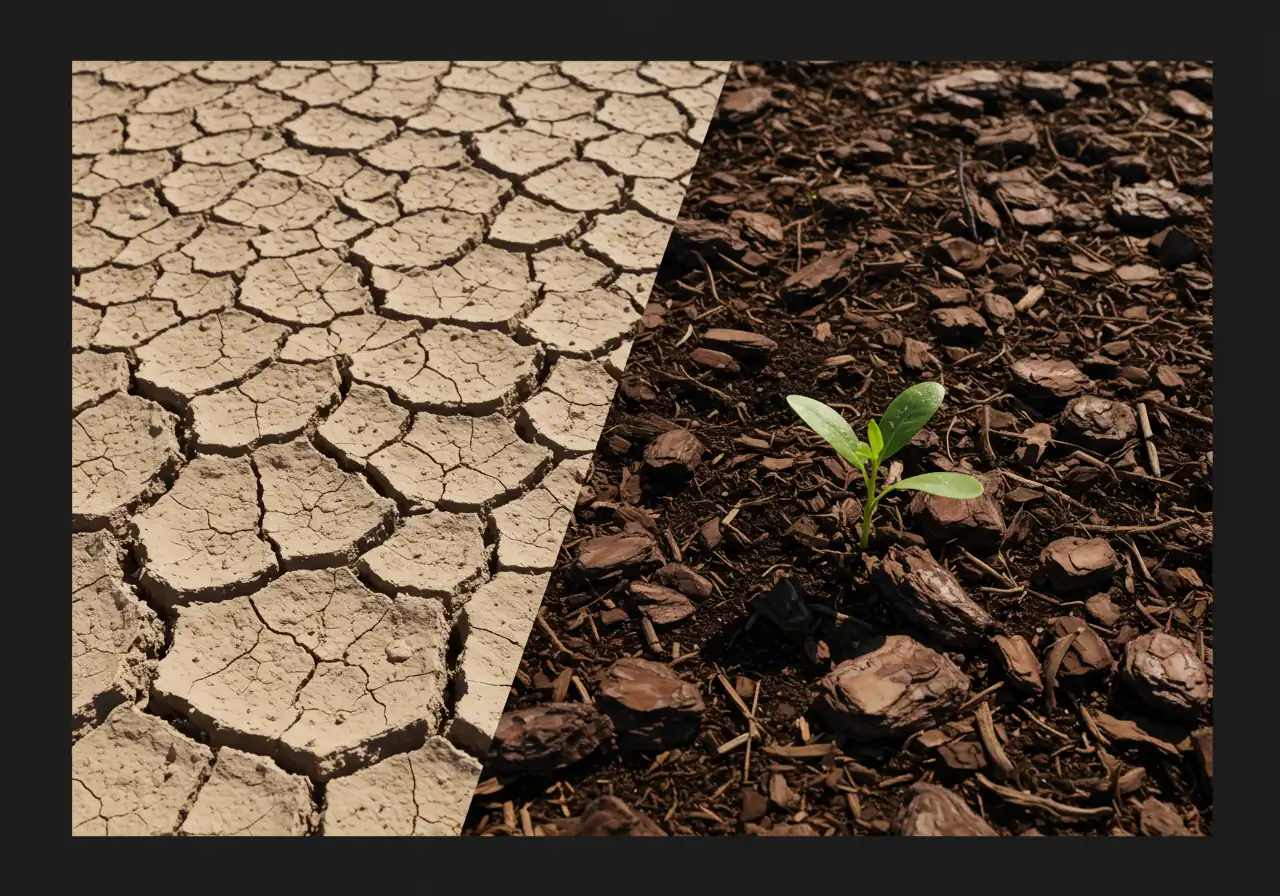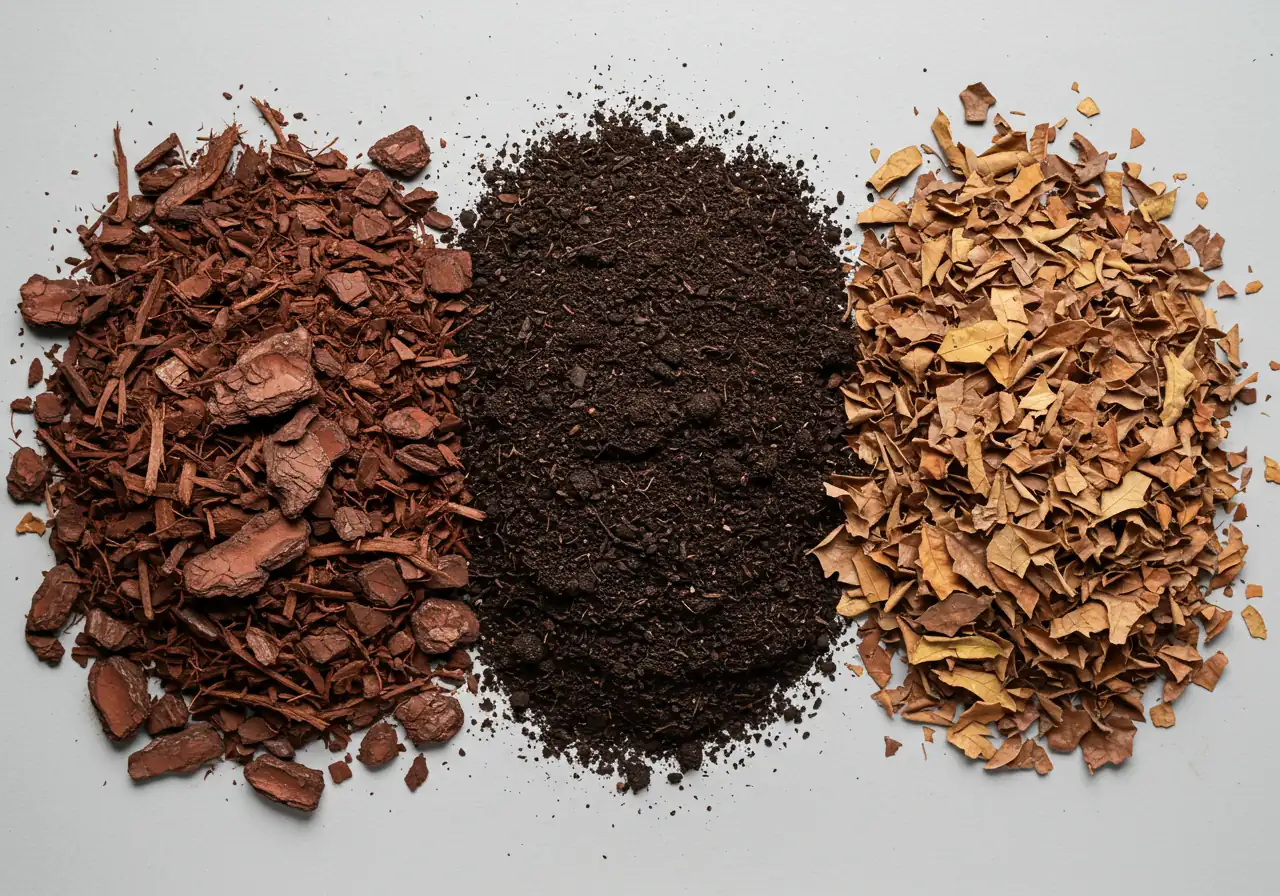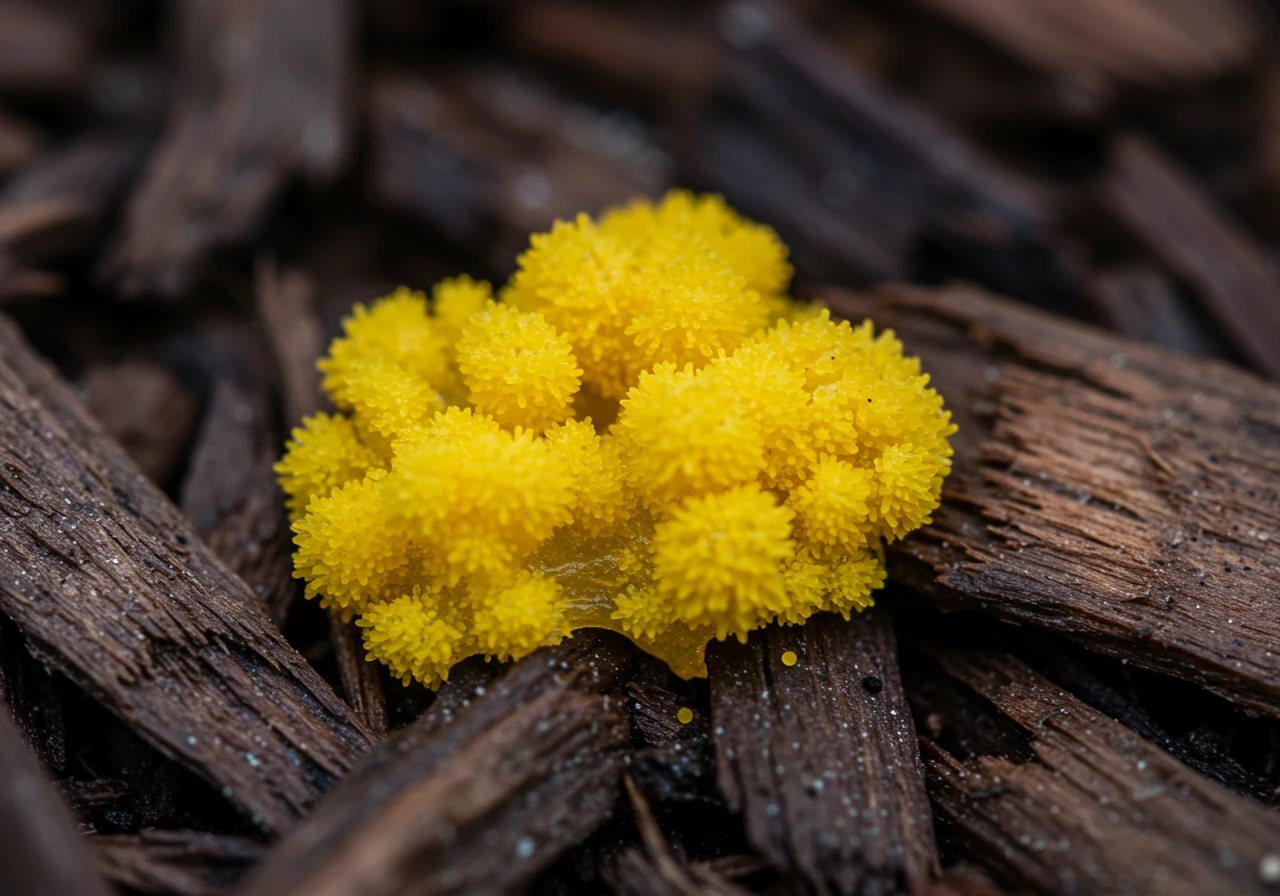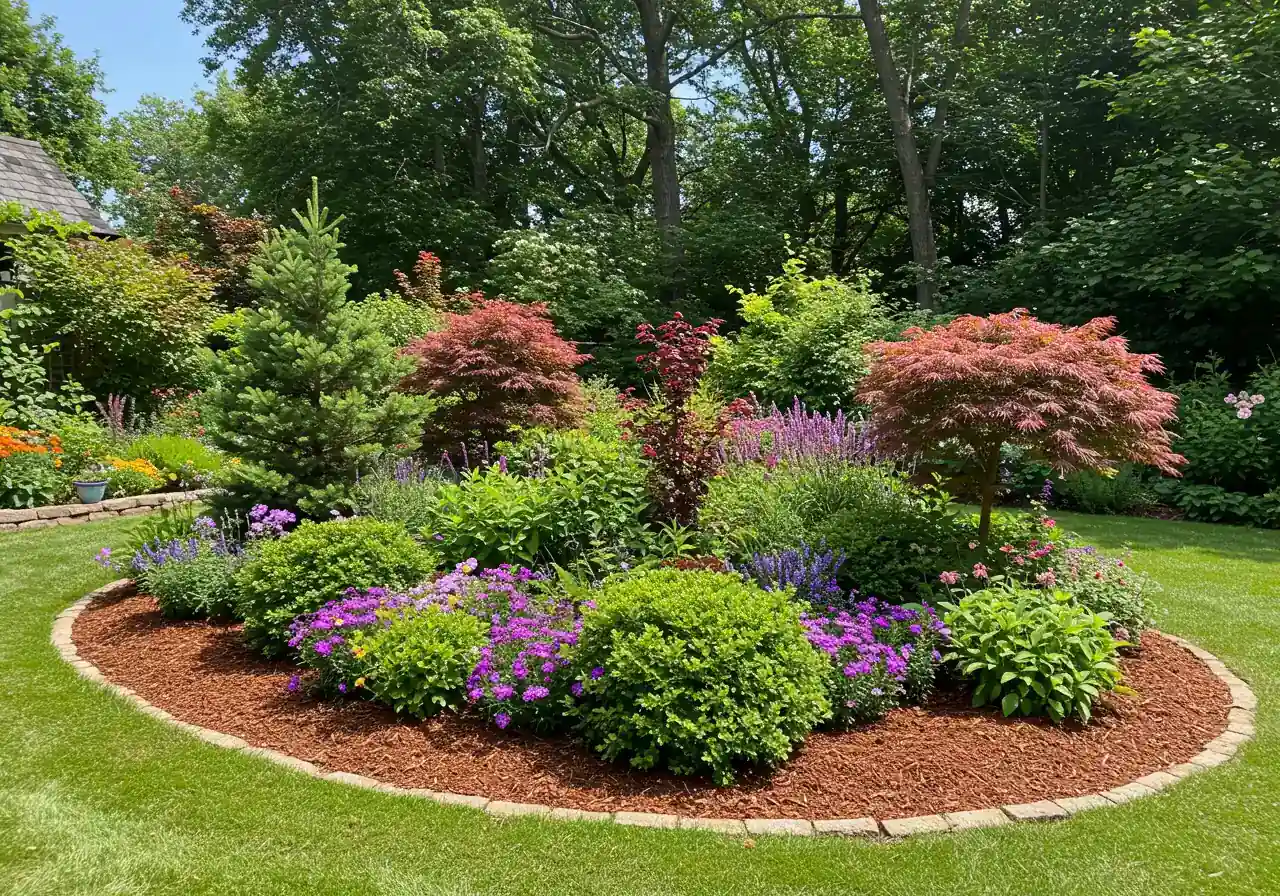Kars Clay Soil Mulching Guide: Save Water & Time Summer
Ah, summer gardening in Kars! Remember trying to plant that lovely shrub last year, only to feel like you were battling concrete instead of soil? You’re not alone. That infamous Kars clay – rock-hard when dry, sticky goo when wet – is a familiar challenge for Ottawa gardeners, whether you’re here or just down the road in Manotick. It can turn hopeful landscaping dreams into a sweaty, frustrating reality.
But what if there was a simple, effective way to improve your soil, slash your watering time, and keep those pesky weeds at bay? Enter the hero of our story: mulch! Proper mulching is one of the smartest gardening moves you can make, especially on our challenging clay. It conserves precious moisture during those hot Ottawa summers, suppresses weeds (meaning less back-breaking work for you!), and slowly improves your soil structure over time.
Quick Guide to Kars Clay Mulching:
- Mulching clay soil saves water and reduces weeding time.
- Use organic mulches (bark, compost) to improve soil structure.
- Apply a 2-3 inch layer, keeping it away from plant stems.
- Top up mulch annually in spring.
- Weed thoroughly before applying mulch.
Consider this your ultimate guide to mastering mulch right here in Kars. We’ll help you ditch the clay-induced headaches and finally reclaim your summer for relaxing, not wrestling with the hose or the hoe!
Why Kars Clay is a ‘Special’ Kind of Challenge (And How Mulch Helps!)

Okay, let’s be honest. Anyone who’s tried gardening in Kars, or even nearby areas like Greely or Metcalfe, knows our soil isn’t exactly light and fluffy loam. That heavy clay? It’s what we kindly call… character building. If you’ve ever felt like you needed a pickaxe instead of a shovel after a dry spell, or watched rainwater just sit there like it’s waiting for an invitation after a storm, you’ve experienced the “special” nature of Kars clay firsthand.
So, what makes it such a challenge for our green thumbs?
- Compaction City: Clay soil particles are super tiny and love to snuggle up close. When dry, they pack together so tightly the soil becomes rock hard. This makes it tough for plant roots to grow, difficult for water to penetrate, and turns digging into an Olympic sport. Seriously, digging large holes for trees or shrubs in dense clay is hard work – it’s worth considering !
- Drainage Dramas: Paradoxically, when that tightly packed clay gets saturated, water has nowhere to go. It drains incredibly slowly, leading to soggy conditions that can literally drown plant roots by cutting off their oxygen supply. Finding reliable information on water management can be helpful; check resources like the Rideau Valley Conservation Authority for local watershed insights.
- Slow to Warm, Quick to Bake: Heavy, dense clay takes longer to warm up in the spring compared to sandier soils, which can delay planting. Then, in the heat of an Ottawa summer, the surface can bake into a hard, cracked crust that water just runs off. Check the City of Ottawa’s water conservation tips for ideas on managing summer watering.
It sounds a bit grim, doesn’t it? But fear not! This is where our garden superhero, mulch, swoops in. Mulch isn’t just decorative; it actively works to counteract these clay soil headaches:
- Improves Soil Structure: This is the big one! As organic mulches (like shredded bark, wood chips, or compost) slowly decompose, they add vital organic matter to the soil. This organic matter works its way down, helping to separate those tiny clay particles. Over time, this creates better pathways for air and water, vastly improving drainage and reducing compaction. Think of it as gradually turning concrete into crumbly chocolate cake (well, almost!). Consider this a long-term investment in your soil preparation strategy.
- Reduces Compaction & Crusting: A layer of mulch acts like a protective shield. It cushions the impact of raindrops that can pound the soil surface and pack it down. It also prevents the sun from baking the top layer into that impenetrable crust, keeping the soil underneath workable.
- Moderates Soil Temperature: Mulch acts as insulation. It helps keep the soil cooler during those hot summer days, reducing stress on plant roots. It also keeps the soil slightly warmer during cooler periods in spring and fall. This temperature buffering provides some root protection, much like the strategies used for .
- Conserves Precious Moisture: Remember how clay surfaces bake and crack? Mulch significantly slows down water evaporation from the soil surface. This means the soil stays moist longer, reducing how often you need to water – a huge bonus during dry spells! Consistent moisture leads to healthier plants overall, which is always a goal, whether you are or simply aiming for vibrant blooms.
- Suppresses Weeds: A good 2-3 inch layer of mulch blocks sunlight, preventing many pesky weed seeds from ever seeing the light of day. Fewer weeds mean less competition for water and nutrients for your desired plants, and less back-breaking weeding for you! Keeping unwanted plants down is essential for and helps maintain that neat appearance often achieved with professional help like expert Nepean property cleanup services.
- Adds Nutrients: As organic mulches break down, they release valuable nutrients right where plants need them, slowly feeding the soil over time.
Working with Kars clay often means improving it, and mulch is your best friend in this endeavour. Applying mulch consistently year after year is one of the most effective ways to make clay soil more manageable and your garden more productive. If the thought of hauling and spreading mulch across large areas seems daunting, remember you can always call in reinforcements; check out our comprehensive landscaping services for professional help.
Picking Your Perfect Mulch Partner: Best Bets for Kars Clay

Alright, garden warriors of Kars, you understand *why* mulch is essential for taming that tricky clay soil. Now comes the fun part – choosing the *right* mulch! It’s like picking a dance partner; you want one that complements your style (or, in this case, your soil) and doesn’t step on your toes (or roots!). With Kars clay, our main goal is improvement, so we’ll focus heavily on the organic options that break down and enrich the soil over time.
Think of organic mulches as slow-release soil conditioners. They are the real heroes for improving heavy clay structure. Here are some top contenders for Ottawa gardens:
1. Shredded Bark / Wood Chips (The Reliable Classic)
- What it is: Shredded or chipped pieces of bark (like cedar or pine) or whole wood. Cedar is particularly popular around Ottawa for its pleasant smell and rot resistance.
- Pros: Breaks down relatively slowly, providing long-lasting coverage. Excellent at suppressing weeds and conserving moisture. Looks neat and tidy. Readily available at garden centers in Nepean, Manotick, and beyond. Part of professional mulching and edging services.
- Cons: Can slightly deplete nitrogen from the *very top* layer of soil as it starts decomposing (easily fixed with a light sprinkle of nitrogen fertilizer *before* mulching). Some lighter wood chips might float away in heavy downpours on slopes.
- Best for: General landscaping, around trees, shrubs, and perennial beds.
2. Compost (The Soil Superstar)
- What it is: Fully decomposed organic matter – basically, black gold for your garden!
- Pros: The *best* option for actively improving soil structure and fertility *quickly*. Adds loads of beneficial microbes. Looks dark and rich.
- Cons: Breaks down faster than wood mulches, so needs replenishing more often (usually annually). If not fully composted, it *could* contain weed seeds. Can be more expensive if buying large quantities.
- Best for: Vegetable gardens, annual flower beds, and giving any planting area a serious boost. Often used as a top-dressing *over* or *mixed with* other mulches.
3. Leaf Mould (The Frugal Friend)
- What it is: Decomposed leaves, especially wonderful if you have oak or maple trees!
- Pros: Free! Excellent soil conditioner, similar benefits to compost. Improves water retention wonderfully.
- Cons: Takes time to make yourself (at least a year). Availability depends on having deciduous trees. Can look less “formal” than bark mulch.
- Best for: Anywhere you’d use compost, woodland gardens, enriching beds before applying a top layer of another mulch. Ensuring your beds are clear of debris before applying is key, similar to the prep work involved in comprehensive garden clean up services like those offered in Marionville.
4. Straw (The Veggie Guardian)
- What it is: Dried stalks of grain plants (make sure it’s straw, *not* hay, which is full of seeds!).
- Pros: Inexpensive, great insulator, good moisture retention, breaks down reasonably well to add organic matter.
- Cons: Can look messy in ornamental beds. Can blow around easily if not weighted down or tucked in. Might contain some stray grain seeds.
- Best for: Vegetable gardens, over-seeding lawns, protecting tender plants over winter.
What About Inorganic Mulches?
Materials like landscape fabric, gravel, or stone are also options, but they play a different role.
- Stone/Gravel: These are permanent and low-maintenance *once installed*. They don’t break down, so they won’t improve your clay soil. They can also absorb and retain heat, which might stress some plants in the peak of an Ottawa summer. Best used for pathways, around foundations, or in very specific landscape designs.
- Landscape Fabric: While often marketed as a weed solution, we generally advise *against* using it directly on top of clay soil in garden beds. It prevents organic mulch from breaking down *into* the soil, hindering that crucial improvement process. It can also become compacted, exposed, and unsightly over time.
Practical Tips for Kars Clay:
- Depth Matters: Apply organic mulches 2-3 inches deep. Too shallow, and weeds pop through; too deep, and you can suffocate plant roots or prevent water from reaching the soil.
- Give Plants Space: Keep mulch pulled back an inch or two from the base of shrubs, trees, and perennials to prevent rot and pests.
- Timing is Everything: Apply mulch in spring after the soil has warmed up a bit but before summer heat and weeds arrive. Fall application after a good cleanup is also beneficial for winter protection and getting a head start on soil improvement. This annual task can be part of regular ongoing garden maintenance plans.
- Prep Your Beds: Before mulching, ensure the area is well-weeded and the soil is reasonably moist. Need help with a large-scale cleanup before mulching? A professional Ottawa yard cleanup service can get your beds ready. For larger properties needing significant work, consider expert Ottawa property cleanup services or services specific to areas like Metcalf yard cleanup service.
Choosing the right mulch might seem like a small detail, but for Kars clay, it’s a strategic move towards a healthier, happier garden. Making an informed choice aligns with our process for material selection. If tackling a big mulching job feels overwhelming, remember that professional help is available. Learn more about us and our approach to creating beautiful, manageable landscapes right here in the Ottawa area. Still have questions about the best fit for your specific garden? Don’t hesitate to get in touch with us for personalized advice! You can also check out our Google My Business page for reviews and updates.
The Art of Mulching: A Step-by-Step Guide for Kars Gardens
Okay, let’s get down to the nitty-gritty – actually *applying* that glorious mulch! It’s not rocket science, but doing it right makes a huge difference, especially in our Kars clay conditions. Think of it as tucking your garden beds in for a cozy, beneficial nap. Here’s your step-by-step guide:
Step 1: Time it Right (Beat the Weeds and Heat!)
In the Ottawa region, the sweet spot is mid-to-late spring (May/early June). Wait for soil to warm, but apply before summer heat and major weed growth. Fall application after cleanup is also beneficial.
Step 2: Prep Like a Pro (Weed ‘Em and Feed ‘Em!)
Remove *all* weeds by the roots. Optional: Edge beds, add a thin compost layer, lightly water dry soil. For big jobs, consider a Metcalf garden clean up service or a Marionville property cleanup service.
Step 3: Spread the Love (But Not Too Thick!)
Apply mulch evenly, aiming for a depth of 2 to 3 inches. Too shallow won’t work well; too deep can harm roots, especially in clay. A consistent layer gives those professional landscaping transformations results.
Step 4: Give Plants Breathing Room (No Mulch Volcanoes!)
Crucial: Pull mulch back 1-2 inches from the base of all plants (trees, shrubs, perennials). Piling mulch against stems invites rot and pests. Avoid “mulch volcanoes”. This is standard practice in professional garden maintenance.
Step 5: Handle Slopes Smartly
On slopes (common near Richmond or Russell), use shredded bark mulch. Create a slightly thicker lip at the bottom edge to catch runaways. For steep slopes, terracing might be needed, something assessed during a Metcalf property cleanup service consultation.
Step 6: Water it In
After spreading, water the entire mulched area thoroughly. This settles the mulch, removes air pockets, and activates its moisture-saving benefits immediately.
And that’s it! You’ve successfully mulched your Kars garden beds. Now sit back, relax, and enjoy less weeding, less watering, and healthier, happier plants thriving in improving soil.
Keeping Your Mulch Working: Seasonal Care & Troubleshooting

So, you’ve laid down that beautiful layer of mulch – nice work! Your Kars garden beds are looking sharp. But hold your watering can, mulch isn’t *quite* a “set it and forget it” affair, especially with our distinct Ottawa seasons. Think of it like a trusty garden helper; it needs a little check-in now and then to keep doing its best work protecting your plants and improving that clay soil. Here’s how to keep your mulch performing like a champ year-round:
Seasonal Check-ins: The Mulch Maintenance Calendar
- Spring Refresh (April-May): As the snow melts and the ground thaws, gently rake the mulch to loosen any compaction. Check the depth and top up to 2-3 inches if needed. Remove any early weeds. Browse our gallery for inspiration on freshly maintained beds.
- Summer Check (June-August): Monitor soil moisture under the mulch – is it damp but not soggy? Watch for pests like slugs near plant bases (keeping mulch pulled back helps). Rake back any mulch washed away by thunderstorms.
- Fall Top-Up & Winter Prep (September-October): After cleaning up fallen leaves and dead annuals (part of a good fall property clean up), consider adding another inch of mulch (not exceeding 3-4 inches total) for winter root insulation, especially for tender plants.
*Illustrative estimates. Actual savings vary based on conditions.
Troubleshooting Those Mulch Mysteries
Even with the best intentions, sometimes things go a bit sideways. Don’t panic! Here are common mulch hiccups and how to handle them:
- Problem: My mulch smells sour and looks slimy!
- The Issue: Usually means mulch is too thick or compacted, lacking air (anaerobic decomposition).
- The Fix: Rake to fluff it up and ensure depth is 3-4 inches max. Persistent soggy *soil* might indicate deeper drainage issues potentially identified during a Metcalf property cleanup service visit.
- Problem: Help! My mulch is hosting a slug convention!
- The Issue: Mulch provides shelter for slugs, earwigs, etc.
- The Fix: Keep mulch 1-2 inches from plant stems. Use eco-friendly baits sparingly if needed. As noted in our terms and conditions, complete pest elimination is often unrealistic.
- Problem: My mulch disappeared / turned into dirt way too fast!
- The Issue: Finer mulches (compost) break down faster than coarser bark. This is good for soil!
- The Fix: Accept that you’ll need to top up annually. It’s feeding your soil!
- Problem: What IS that weird orange/yellow/black stuff growing on my mulch?
- The Issue: Likely harmless slime mold (yellow/orange) or annoying artillery fungus (black dots). They are decomposers.
- The Fix: Slime mold can be ignored, scooped, or rinsed off. Remove mulch affected by artillery fungus if it’s staining surfaces. Neither usually harms plants.
Remember to use natural, undyed organic mulches whenever possible. They feed the soil web and contribute to a healthier overall landscape, creating a great foundation for everything from flower beds to supporting healthy grass after a sod installation. A little seasonal attention keeps your mulch working effectively, saving you time and effort in the long run!
HIGHLIGHT BOX: Kars Clay Mulching Quick Wins
Feeling overwhelmed by that Kars clay? Don’t throw in the trowel just yet! Mulching is your secret weapon. Here are the absolute must-do’s to turn that sticky situation into gardening gold, saving you sweat and water bills this Ottawa summer:
- Go Organic for the Win: Forget plastic sheeting under your mulch here! To *actually improve* that tough Kars or Greely clay, choose organic mulches like shredded bark, compost, or leaf mould. These break down, adding precious organic matter. Making smart material selection is step one for long-term soil health. For local gardening advice, groups like the Ottawa Master Gardeners can be a great resource.
- The Goldilocks Depth: Not too deep, not too shallow! Aim for a consistent 2-to-3-inch layer. Too little won’t stop weeds; too much can suffocate roots, especially in dense clay. Getting this right is key to proper mulching and edging techniques.
- Give ‘Em Space! (No Mulch Volcanoes): Seriously, pull that mulch back 1-2 inches from the base of *all* plants – trees, shrubs, flowers. Piling it against stems is like sending an engraved invitation to rot and pests, whether you’re in Kars or Osgoode. Let them breathe!
- Feed the Beast (Your Soil, That Is): Organic mulch gets “eaten” by your soil (which is good!). Check the depth each spring and fall. You’ll likely need to top it up annually to maintain that crucial 2-3 inch layer and keep the soil improvement going. If the job feels too big, don’t hesitate to book an estimate for mulching services – we handle the heavy lifting! After you submit your request online (rest assured, you can review our privacy policy regarding your information), you’ll land on our thank you page. You can also provide feedback later via our estimate feedback form or access your info through the customer portal.
- Prep Before You Spread: Always weed thoroughly *before* applying mulch. Covering existing weeds just gives them a cozy blanket to grow under, which kind of defeats the purpose! A clean slate makes your mulch work much better and look way nicer right from the start.
Follow these quick wins, and you’ll be well on your way to conquering Kars clay and enjoying a more beautiful, less demanding garden!
FAQs: Your Kars Clay & Mulching Questions Answered
Okay, let’s tackle those frequently asked questions about mulching, especially for those of us wrestling with that charming Kars clay!
Great question! Because organic mulches are awesome and break down to improve our heavy Kars clay, they do disappear over time. Plan on topping up your mulch layer by about an inch each spring. This keeps it at that ideal 2-3 inch depth for weed suppression and moisture retention, continuing the soil improvement magic. You usually don’t need a full replacement unless you want a different look!
Okay, real talk: Mulch is a *fantastic* weed suppressor, but it’s not an impenetrable force field (darn!). A good 2-3 inch layer blocks light for *new* weed seeds. However, really determined perennial weeds might still poke through. Proper bed prep, like a thorough Ottawa garden clean up service, *before* mulching makes a huge difference. Think of mulch as drastically reducing weeding, not eliminating it entirely – like the work done during a Marionville yard cleanup service reduces future clutter.
You heard partly right, but don’t lose sleep over it! Fresh wood mulch *can* temporarily use a little nitrogen right at the soil surface as it starts decomposing. However, it rarely affects established plants significantly. If you’re concerned, especially with new plantings, just sprinkle a light layer of compost or a nitrogen-rich organic fertilizer *before* applying mulch. It’s all part of good soil preparation.
Generally, no – quite the opposite! Organic mulch helps *improve* drainage in Kars clay over time by preventing surface crusting and adding organic matter as it breaks down. The only way it could potentially worsen drainage is if you apply it way too thick (like 6+ inches), creating a barrier. Stick to that 2-3 inch sweet spot, and you’ll be helping, not hurting!
Ah yes, the occasional mulch migration after an Ottawa storm, especially in open areas like near Richmond or Kenmore! Using heavier, shredded bark mulch helps as it knits together better than fine chips. Creating a defined edge for your beds also contains it. If scattering happens, just rake it back into place. For widespread mess after severe weather, help is available through services like an Ottawa property cleanup service.
Absolutely! Spreading mulch over large areas can feel like training for a marathon. Consider ordering mulch in bulk (cubic yards) delivered instead of wrestling with bags. Use a wheelbarrow and a tarp to move large amounts easily. If the sheer scale is daunting, remember professional landscapers offer mulching as a service, sometimes included in larger projects like a complete garden install. Many hands make light work! You can easily request an estimate for this service.
Conclusion: Mulch Smarter, Not Harder in Your Kars Garden This Summer

So there you have it! Mulching isn’t just about making your Kars garden beds look tidy; it’s one of the smartest landscaping moves you can make, especially on our challenging clay soil. Think of all the benefits we’ve covered: saying goodbye to endless weed suppression battles, enjoying significant water conservation (which means lower bills and happier plants during dry Ottawa spells!), and actively kickstarting long-term soil improvement. It really is about working smarter, not harder.
Imagine spending less time wrestling with the hose or pulling weeds under the summer sun, and more time actually enjoying your beautiful outdoor space, maybe sipping lemonade while admiring your thriving plants. That’s the power of proper gardening with mulch! By taking these steps, you’re not just improving your own patch; you’re contributing to the beauty of our Kars and Manotick communities.
Ready to spend less time working and more time relaxing this summer?
Get Your Free Mulching Estimate
Want to see more examples of our work? Check out our project gallery or our transformations page!

